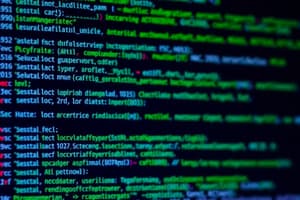Podcast
Questions and Answers
Which of the following is NOT a characteristic of the C programming language?
Which of the following is NOT a characteristic of the C programming language?
- Consistent and cohesive
- Designed by a committee (correct)
- Low-level language
- Small and simple
C hides the underlying system and machine workings from the programmer.
C hides the underlying system and machine workings from the programmer.
False (B)
Which of the following languages are derived from C?
Which of the following languages are derived from C?
- Java
- Python
- C++
- All of the above (correct)
In C programming, where does the execution of a program begin?
In C programming, where does the execution of a program begin?
A header file is included in a C code file using the ______ statement.
A header file is included in a C code file using the ______ statement.
What is the primary purpose of the include statement in header files in C programming?
What is the primary purpose of the include statement in header files in C programming?
Header files can only include standard library header files.
Header files can only include standard library header files.
What are the two main types of files that compose a C program?
What are the two main types of files that compose a C program?
What is contained in header files pertaining to compile-time artifacts?
What is contained in header files pertaining to compile-time artifacts?
Header files are ______ by other files in C programming.
Header files are ______ by other files in C programming.
Why are header files necessary in C programming?
Why are header files necessary in C programming?
The C compiler processes multiple files at the same time.
The C compiler processes multiple files at the same time.
What should a code file include to ensure that the manifest matches the code?
What should a code file include to ensure that the manifest matches the code?
Match the following C file types with their descriptions:
Match the following C file types with their descriptions:
Which preprocessor command is used to insert the contents of a header file into a C source file?
Which preprocessor command is used to insert the contents of a header file into a C source file?
In C, it is acceptable to define functions and variables in header files.
In C, it is acceptable to define functions and variables in header files.
What is the role of the linker in the C build process?
What is the role of the linker in the C build process?
The C compiler created object files, but the ______ creates executable files.
The C compiler created object files, but the ______ creates executable files.
Which of the following functionalities is provided by libraries in C?
Which of the following functionalities is provided by libraries in C?
In Java, linking is performed at compile time, similar to C.
In Java, linking is performed at compile time, similar to C.
Which of the following is a key difference between C and Java concerning type information?
Which of the following is a key difference between C and Java concerning type information?
In the C build process, what is the purpose of the preprocessor?
In the C build process, what is the purpose of the preprocessor?
The C compiler translates source code into ______ code.
The C compiler translates source code into ______ code.
What is the correct order of steps in the C build process?
What is the correct order of steps in the C build process?
Every C code file must have a corresponding header file.
Every C code file must have a corresponding header file.
What does the extern keyword indicate?
What does the extern keyword indicate?
What is the file extension typically used for C header files?
What is the file extension typically used for C header files?
In C, a struct is the rough equivalent of a ______ in other languages.
In C, a struct is the rough equivalent of a ______ in other languages.
Given a program that reads N numbers and outputs them in reverse order, what is the correct order of output if the input is '5 42 36 97 7 13'?
Given a program that reads N numbers and outputs them in reverse order, what is the correct order of output if the input is '5 42 36 97 7 13'?
Header files are compiled independently of code files.
Header files are compiled independently of code files.
What is the role of the assembler in the C build process?
What is the role of the assembler in the C build process?
What is the command to compile two c files named 'main.c' and 'stack.c' and create an executable named 'reverse'?
What is the command to compile two c files named 'main.c' and 'stack.c' and create an executable named 'reverse'?
The program revstr reads a specified number of ______ and outputs them in reverse order.
The program revstr reads a specified number of ______ and outputs them in reverse order.
Which of the following is NOT a learning outcome mentioned for the 'Number Reverse' problem?
Which of the following is NOT a learning outcome mentioned for the 'Number Reverse' problem?
Header files should contain the implementation (definition) of functions, rather than just the declaration.
Header files should contain the implementation (definition) of functions, rather than just the declaration.
What would happen if you included a header file in multiple code files, and that header file contained a variable definition?
What would happen if you included a header file in multiple code files, and that header file contained a variable definition?
What does 'stdout' represent in the context of C programming?
What does 'stdout' represent in the context of C programming?
The best practice dictates that a header file should have the same name as its corresponding ______ file.
The best practice dictates that a header file should have the same name as its corresponding ______ file.
Initially, 'The C Programming Language' was described in a book consisting of how many pages?
Initially, 'The C Programming Language' was described in a book consisting of how many pages?
The assembly (.s) files are created during the typical build process.
The assembly (.s) files are created during the typical build process.
Which of the following is the most accurate description of the steps performed by a C compiler?
Which of the following is the most accurate description of the steps performed by a C compiler?
Why was C created originally when computers were slow and with small memories?
Why was C created originally when computers were slow and with small memories?
______ should be declared(not defined) in the corresponding header file.
______ should be declared(not defined) in the corresponding header file.
Flashcards
What is C?
What is C?
A low-level language ideal for manipulating data at the hardware level, commonly used for device drivers, O/S Modules, and embedded systems.
Why learn C?
Why learn C?
Understanding how the system and machine operate, implementing data structures while being aware of trade-offs, and looking "under the hood".
What are the two kinds of files in C programs?
What are the two kinds of files in C programs?
Code files (.c) and header files (.h).
What is a declaration in C?
What is a declaration in C?
Signup and view all the flashcards
What is a definition in C?
What is a definition in C?
Signup and view all the flashcards
What is the purpose of the #include statement?
What is the purpose of the #include statement?
Signup and view all the flashcards
What happens during the C compilation process with #include?
What happens during the C compilation process with #include?
Signup and view all the flashcards
What are the two types of include statements?
What are the two types of include statements?
Signup and view all the flashcards
Why use header files?
Why use header files?
Signup and view all the flashcards
Why are header files necessary for compilation?
Why are header files necessary for compilation?
Signup and view all the flashcards
What does the 'extern' keyword indicate?
What does the 'extern' keyword indicate?
Signup and view all the flashcards
What are the steps in the C build process?
What are the steps in the C build process?
Signup and view all the flashcards
How are C files compiled?
How are C files compiled?
Signup and view all the flashcards
What does the Linker do?
What does the Linker do?
Signup and view all the flashcards
How does Java differ from C in linking?
How does Java differ from C in linking?
Signup and view all the flashcards
What is a C commandment regarding header files?
What is a C commandment regarding header files?
Signup and view all the flashcards
What is another C commandment regarding header files?
What is another C commandment regarding header files?
Signup and view all the flashcards
Where should external functions/variables be declared?
Where should external functions/variables be declared?
Signup and view all the flashcards
Study Notes
Why Learn C?
- C is a low-level language suited for data and hardware manipulation (device drivers, O/S modules, embedded systems).
- It's small, simple, consistent, and cohesive, designed by Denis Ritchie at Bell Labs, initially described in a 261-page book.
- C features a huge code-base and a standard tool-chain, making it the language of choice for system programming.
Why Learn C? (Really)
- C requires understanding of the system and machine operations and doesn't conceal anything.
- Implementation of data structures is required, so awareness of all trade-offs is gained.
- C forces the user to look "under the hood".
Where to Start Learning C?
- C has similarities with languages like Java, as many languages are derived from C.
- The syntax is nearly identical in loops, if statements, local variables, expressions, etc and execution starts in main().
- Operations, such as output are very similar to Java.
Alternative Start To Learning C
- There is existing knowledge of C code due to familiarity with Java.
- Study should focus on organization of C programs (code/header files), the build process, and C commandments.
C File Composition
- C programs consist of code files (.c) and header files (.h).
- Header files contain definitions and information about run-time artifacts (function and variable declarations).
- Code files contain both compile-time and run-time artifacts, being those used when the program is compiled or running, global or static functions and variables.
- Header files are included by other files.
Header Files and #include
- A header file is "included" via the #include statement, inserting the header file content at compile time.
- #include includes standard library header files, while #include "file" includes program-specific header files.
- Header files may include other header files as well.
Why Header Files?
- Necessary because the C build process compiles each C file independently.
- They avoid duplicate type definitions across files and provide a manifest of runtime artifacts.
Avoiding Duplicate Type Declarations
- Type declarations are used at compile time.
- Defining a type in multiple code files leads to errors.
- Use header files to define a type used by multiple code files.
Manifest of a Code File
- The C compiler can only process one file at a time, and cannot do error checking if a function or variable is used from another file.
- Header files act as manifests containing type definitions, function declarations, and variable declarations.
- The header file containing the "manifest" is included by code files that use those types, functions and variables.
- It's a best practice for header file and code file names to match, and for code files to include their corresponding header files (e.g., stack.c includes stack.h).
The C Build Process
- The build process includes preprocessing, compiling, assembling, and linking.
Larger Programs
- Compiling commands will look like: gcc –Wall –o reverse main.c stack.c
- The code base of a larger project consist of: main.c, stack.c, stack.h and node.h
Individually Compiled C Files
- Key concept is that each C file is compiled individually without reading other C files except for included header files during preprocessing.
Linker Role
- The linker builds the executable from object files and standard libraries (stdio, stdlib).
- The linker expects a main function as the starting point.
Key Differences From Java
- Java performs linking at runtime.
- Java (.java) files are compiled into class (.class) files individually.
- Type information is stored and used, as a runtime artifact, in the class files.
- Class files run to link classes at runtime.
The C Commandments
- Never put function or variable definitions in header files to avoid multiple definitions.
- Every code file (besides the one with main()) should have a corresponding header file.
- Declare all functions and variables used outside of a code file in the corresponding header file.
Learning Through Coding in C
- Knowledge of Java can accelerate learning C.
- Writing programs to identify and address the differences promotes learning.
- Initial topics: Basic I/O, arrays, strings, references (pointers).
Number Reversal Program
- Goal: Create a program (revnum) that reads a specified number of integers and outputs them in reverse order, using stdin/stdout.
- Input:
- An integer N (followed by N integers on separate whitespace).
- Output:
- N integers in reverse order, one per line.
- Learning:
- Setting up main() function
- Using scanf and printf
- Defining and using arrays
String Reversal Program
- Goal: Create a program (revstr) that reads a specified number of words and outputs them in reverse order.
- Input:
- An integer N, followed by N strings separated by white-space (strings are at most 49 characters).
- Output:
- The N strings in reverse order, one per line (stdout).
- Learning:
- String representation in C
- Reading, storing, and writing strings
- References in C [maybe]
Studying That Suits You
Use AI to generate personalized quizzes and flashcards to suit your learning preferences.




